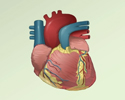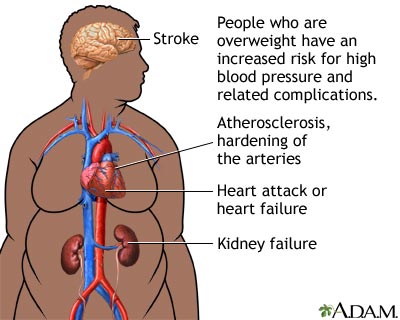Health risks of obesity
Obesity means weighing more than what is healthy for a given height. Obesity is a serious, chronic disease. It can lead to other health problems, including diabetes, heart disease, and some cancers.
People with obesity have a higher chance of developing these health problems:
Obesity
Obesity means weighing more than what is healthy for a given height. Obesity is a serious, chronic disease. It can lead to other health problems, i...

- High blood glucose (sugar) or diabetes.
Diabetes
Diabetes is a long-term (chronic) disease in which the body cannot regulate the amount of sugar in the blood.
 ImageRead Article Now Book Mark Article
ImageRead Article Now Book Mark Article - High blood pressure (hypertension).
High blood pressure
Blood pressure is a measurement of the force exerted against the walls of your arteries as your heart pumps blood to your body. Hypertension is the ...
 ImageRead Article Now Book Mark Article
ImageRead Article Now Book Mark Article - High blood cholesterol and triglycerides (dyslipidemia, or high blood fats).
High blood cholesterol
Cholesterol is a fat (also called a lipid) that your body needs to work properly. Too much bad cholesterol in your blood can increase your chance of...
 ImageRead Article Now Book Mark Article
ImageRead Article Now Book Mark Article - Heart attacks due to coronary heart disease, heart failure, and stroke.
Heart attacks
Most heart attacks are caused by a blood clot that blocks one of the coronary arteries. The coronary arteries bring blood and oxygen to the heart. ...
 ImageRead Article Now Book Mark Article
ImageRead Article Now Book Mark ArticleCoronary heart disease
Coronary heart disease is a narrowing of the blood vessels that supply blood and oxygen to the heart. Coronary heart disease (CHD) is also called co...
 ImageRead Article Now Book Mark Article
ImageRead Article Now Book Mark ArticleHeart failure
Heart failure is a condition in which the heart is no longer able to pump oxygen-rich blood to the rest of the body efficiently. This causes symptom...
 ImageRead Article Now Book Mark Article
ImageRead Article Now Book Mark ArticleStroke
A stroke occurs when blood flow to a part of the brain stops. A stroke is sometimes called a "brain attack. " If blood flow is cut off for longer th...
 ImageRead Article Now Book Mark Article
ImageRead Article Now Book Mark Article - Bone and joint problems. More weight puts pressure on the bones and joints. This can lead to osteoarthritis, a disease that causes joint pain and stiffness.
Osteoarthritis
Osteoarthritis (OA) is the most common joint disorder. It is due to aging and wear and tear on a joint.
 ImageRead Article Now Book Mark Article
ImageRead Article Now Book Mark Article - Sleep apnea or breathing pauses during sleep. This can cause daytime fatigue or sleepiness, poor attention, and problems at work.
- Gallstones and liver problems.
Gallstones
Gallstones are hard deposits that form inside the gallbladder. These may be as small as a grain of sand or as large as a golf ball.
 ImageRead Article Now Book Mark Article
ImageRead Article Now Book Mark Article - Some cancers.
Three things can be used to determine if a person's weight gives them a higher chance of developing obesity-related diseases:
- Body mass index (BMI)
BMI
A good way to decide if your weight is healthy for your height is to figure out your body mass index (BMI). You and your health care provider can us...
 ImageRead Article Now Book Mark Article
ImageRead Article Now Book Mark Article - Waist size
- Other risk factors the person has (a risk factor is anything that increases your chance of getting a disease)

Obesity and health
Obesity increases a person's risk of illness and death due to diabetes, stroke, heart disease, hypertension, high cholesterol, and kidney and gallbladder disease. Obesity may increase the risk for some types of cancer. It is also a risk factor for the development of osteoarthritis and sleep apnea.
Body Mass Index
Experts often rely on BMI to determine if a person is overweight. The BMI estimates your level of body fat based on your height and weight.
Starting at 25.0, the higher your BMI, the greater is your risk of developing obesity-related health problems. These ranges of BMI are used to describe levels of risk:
- Overweight (not obese), if BMI is 25.0 to 29.9
- Class 1 (low-risk) obesity, if BMI is 30.0 to 34.9
- Class 2 (moderate-risk) obesity, if BMI is 35.0 to 39.9
- Class 3 (high-risk) obesity, if BMI is equal to or greater than 40.0
There are many websites with calculators that give your BMI when you enter your weight and height.
For individuals, BMI is a screening tool, but it does not diagnose body fatness or health. Your health care provider can evaluate your health status and risks. If you have questions about your BMI, talk with your provider.
Other methods to measure body fatness include skinfold thickness measurements (with calipers), underwater weighing, bioelectrical impedance, dual-energy x-ray absorptiometry (DXA), and isotope dilution. However, these methods are not always readily available.
Waist Size
Women with a waist size greater than 35 inches (89 centimeters) and men with a waist size greater than 40 inches (102 centimeters) have an increased risk for heart disease and type 2 diabetes. People with "apple-shaped" bodies (waist is bigger than the hips) also have an increased risk for these conditions.

Different types of weight gain
Weight gain in the area of and above the waist (apple type) is more dangerous than weight gained around the hips and flank area (pear type). Fat cells in the upper body have different qualities than those found in hips and thighs.
Risk Factors
Having a risk factor for a disease doesn't mean that you will get the disease. But it does increase the chance that you will. Some risk factors, like age, race, or family history can't be changed.
The more risk factors you have, the more likely it is that you will develop the disease or health problem.
Your risk of developing health problems such as heart disease, stroke, and kidney problems increases if you have obesity and have these risk factors:
- High blood pressure (hypertension)
- High blood cholesterol or triglycerides
- High blood glucose (sugar), a sign of diabetes
These other risk factors for heart disease and stroke are not caused by obesity:
- Having a family member under the age of 50 with heart disease
- Being physically inactive or having a sedentary lifestyle
- Smoking or using tobacco products of any kind
Summing it up
You can control many of these risk factors by changing your lifestyle. If you have obesity, your provider can help you begin a weight-loss program. A starting goal of losing 5% to 10% of your current weight will significantly reduce your risk of developing obesity-related diseases.
Reviewed By
Linda J. Vorvick, MD, Clinical Professor, Department of Family Medicine, UW Medicine, School of Medicine, University of Washington, Seattle, WA. Also reviewed by David C. Dugdale, MD, Medical Director, Brenda Conaway, Editorial Director, and the A.D.A.M. Editorial team.
Centers for Disease Control and Prevention website. Overweight and obesity. www.cdc.gov/obesity/index.html. Updated September 27, 2022. Accessed July 30, 2023.
Jensen MD. Obesity. In: Goldman L, Schafer AI, eds. Goldman-Cecil Medicine. 26th ed. Philadelphia, PA: Elsevier; 2020:chap 207.
Ramu A, Neild P. Diet and nutrition. In: Naish J, Syndercombe Court D, eds. Medical Sciences. 3rd ed. Philadelphia, PA: Elsevier; 2019:chap 16.
 All rights reserved.
All rights reserved.